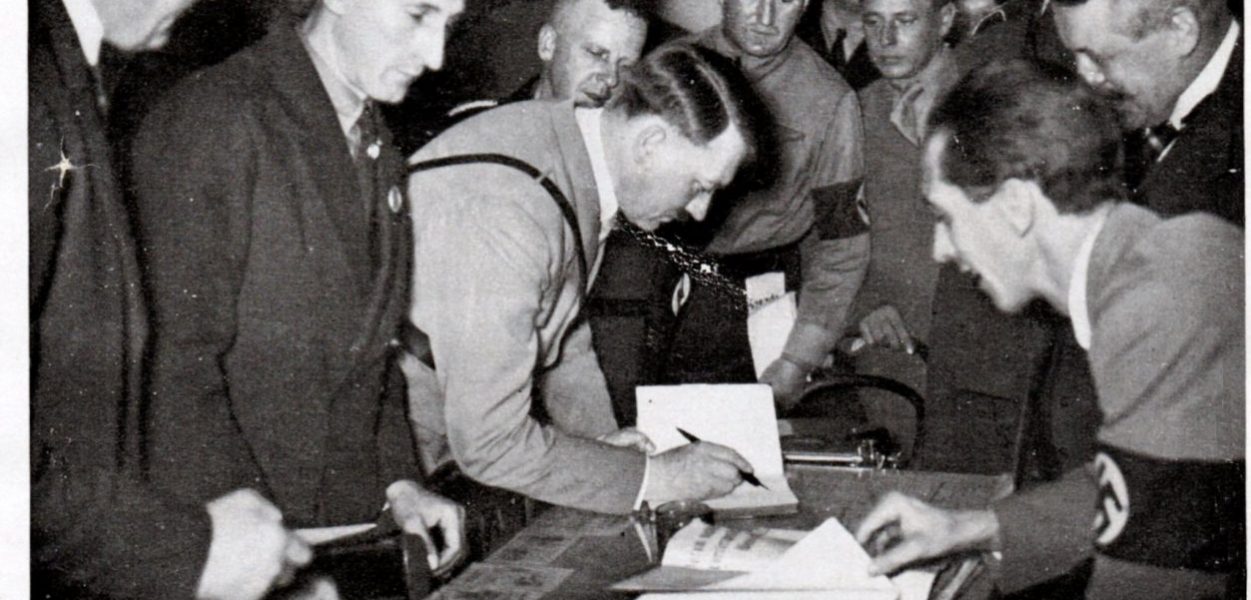Art in Nazi Germany
Michael H. Kater—
One morning late in October 1938 the Viennese poet Josef Weinheber rose from among 250 of his compatriots assembled in the landmark Elephant hotel in Weimar. Fortified by two bottles of wine he stepped up to the lectern at the front of the hall and gave what contemporaries experienced as a rousing speech in honor of Friedrich Hölderlin, the Romantic poet and a particular favorite of the Nazis. It was in the aftermath of Germany’s annexation of Austria, and Weinheber and his friends were buoyed by pride and gratitude when in the evening they returned from Weimar’s classical treasures to listen to Dr. Goebbels, who delivered the concluding address to what had been politically arranged as a German poets’ meeting, the first of several to follow. As Goebbels spoke Weinheber, encouraged by more bottles of wine, interrupted the minister enthusiastically, time and again shouting “Heil Hitler!,” thus seriously encumbering the flow of Goebbels’s speech. Knowing how fond Weinheber was of Hitler and he of him, two towering SS men eventually approached him gently, persuading him to retire to his room upstairs. Goebbels was able to make his points unbroken; Weinheber, an acute alcoholic, years later committed suicide during the Red Army’s approach to Vienna.
The presence of prominent writers from the new Ostmark and the soon-to-be-occupied Sudetenland was crucial for Goebbels, in order to illustrate the significance of Nazi politics in general, and the prerogative of such politics over poetry in particular. All culture, insinuated Goebbels, had to be subservient to the state in times of national alert, it had to play an integral part in the state’s totalitarian fabric. German writers had to be reminded of this, as had all other artists in the Reich. It was clear that this was not the first time Goebbels was issuing such demands, but knowing that the Reich was on an expansionist course and facing what was an unusually receptive audience, the minister seized the occasion to remobilize the intellectuals and artists of the realm.
The timely reminder was issued in Goebbels’s capacity as Minister of People’s Enlightenment and Propaganda. The pairing of those two terms to serve as one functional heading for the ministry had not occurred as a result of an idle whim but was a carefully considered move: guidance of the people to be administered by messages created and manipulated in accordance with the requirements of the day, and exclusively in the interests of the regime leaders. The concept was originally traceable to Hitler’s Mein Kampf, and it was he who had issued the decree anointing Goebbels, in March of 1933. At the end of June, Hitler elaborated that Goebbels was responsible for “all duties relating to the spiritual influence of the nation, to the promoting of the state, culture and the economy.” From this Goebbels deduced a mandate to define culture as an instrument of propaganda, looking upon it as a life-giving elixir of the racially cast Volksgemeinschaft and, successively, as an expression of that people’s community. “The essence of propaganda,” maintained Goebbels, “invariably has to be simplicity, as well as repetition.” Within that framework, the contents of propaganda were to rely on truths, half-truths, and outright lies, as would befit Nazi politics. The interdependence of culture, propaganda, and politics was constantly emphasized by Goebbels – counting from the time of his appointment – and paid continuous lip service by his employees, parroted by officials in every bureaucratic nook and cranny of the Reich. An important part of this effort was bolstering the already existing “Hitler Myth,” starting with popular-cultural events, including films, and reaching the sometimes absurd heights of state-sponsored hymnic scripture.
There could be no such thing as art for art’s sake; in the Nazi cosmos, art was tendentious. As the “standard bearer of national culture,” as Goebbels called it, art could assume many forms and cast the artist in various roles, and it served several purposes for the state. The first use was, not surprisingly, to influence popular attitudes toward the regime, with the aim of achieving total acquiescence with its policies. As George L. Mosse has written, “in the Third Reich the central task of culture was the dissemination of the Nazi world view.” This required, for example, racial norms to be adopted, such as the images of blond, blue-eyed “Aryans” in paintings. Anyone who refused to be conditioned in this way was to be marked as a deviant, either to be brought into line or removed from the Volksgemeinschaft. Another use of culture, high or low, was entertainment, to keep the people satisfied, diverting their attention from problems in the community, such as joblessness early in the regime or the dearth of potatoes and shoe leather at the height of the war. There was, therefore, not one cultural genre in the Third Reich, not a single product of cultural creativity, which, however seemingly innocent, was not of political value, barring Nazi censorship. Yet a third use was to impress foreign governments, which would cede credit to the Berlin regime as a world advocate of civilization, such as when Hitler decided to continue favoring Richard Strauss after 1935, although he had given cause for being blacklisted. During the war, impressing foreign governments took second place to brainwashing chosen groups in occupied territories, such as the Flemish in Belgium who had to be reminded of a common Germanic heritage.
From Culture in Nazi Germany by Michael H. Kater. Published by Yale University Press in 2020. Reproduced with permission.
Michael H. Kater is Distinguished Research Professor Emeritus of History at York University, Toronto, and a fellow of the Royal Society of Canada. His previous publications include Weimar: From Enlightenment to the Present and Hitler Youth.
Further Reading:





